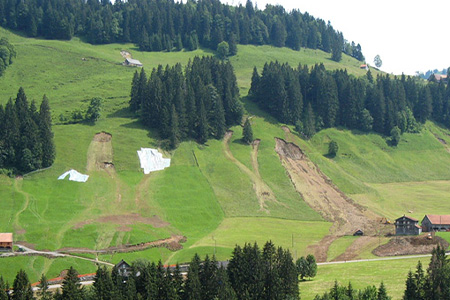The years between 1997 and 2007 have brought Switzerland an above average number of weather catastrophes with several deaths and damage costing billions of Francs. Within minutes enormous downpours turned streams into raging floods and caused slopes to slip. Mud, stones, boulders and whole trees were washed down into the valleys flooding villages, cultivated land and traffic routes. After such catastrophes the danger is not over. The resulting soil slip scars harbour the potential for another disaster.
Previously, engineers used concrete and steel to stabilise such "damaged" slopes. To be able to stabilise a slope in such a way, the whole area must be more or less totally built over in order to achieve the necessary protection required. Accordingly intervention in the natural surroundings and landscape is massive and the costs accordingly high. Bioengineering relies on nature, especially on plants for extensive area protection. They are able to interweave with the soil and stabilise the slopes.
Plants and fungi as soil stabilisers
Plants possess a unique combination of functions for stabilising and securing unstable slopes: with their aerial parts the plants cover the soil. Their branches and foliage reduce the precipitation impact energy and therefore surface erosion. With their roots they brace the soil material and draw out water. They therefore reduce the danger of water logging and soil slips. But there is a catch: for plants to be able to fulfil this role they have to grow – under the adverse soil and terrain conditions on unstable slopes, not the easiest of things (Fig. 1a).
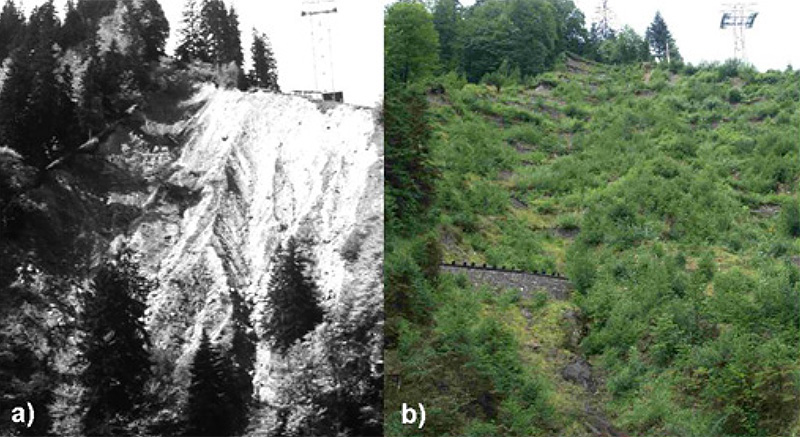
Fig. 1 - a) Erosion and slide area Dallenwil- Wirzweli (NW) in an untreated condition. b) 25 years after the combined technical-biological stabilising measures, carried out in 1982. Photos: Werner Gerber and Frank Graf (WSL)
However, the solution can be found on a plate: porcini, chanterelles and co. Who has not enjoyed these fungi as a delicacy? The fact that nearly all plants have a close relationship with fungi is not well known. Porcini, chanterelle and fly agaric / mushroom (amanita) are only three of the best known representatives of many species of fungi which live with plants in a root symbiosis (Mycorrhiza). Whilst the plant provides sugar for the fungi through photosynthesis, the fungi helps the plant – like a gardener – mainly with the supply of water and nutrients (Fig. 2). They colonise the hair roots of their host plant and penetrate the body of soil with countless fine threads (Hyphae). The circumference of these hyphae (2-5µm) is much smaller than that of the root.
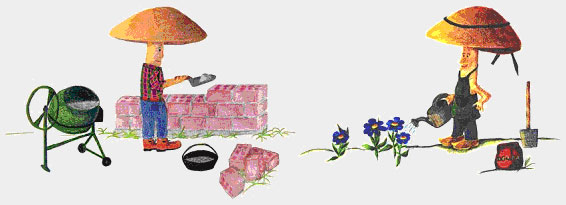
Fig. 2 - The fungal part of the root symbiosis (Mycorrhizal fungi) cements together the loose soil particles into a stable soil structure with their "bricklayer function". With their "gardener function" they help their plant partners achieve improved and quicker growth.
The fungi thus achieve much larger water and nutrient reserves and the uptake area of the plant root is increased by up to fifty times. The result: plants and especially their roots grow better and quicker (Fig. 3).
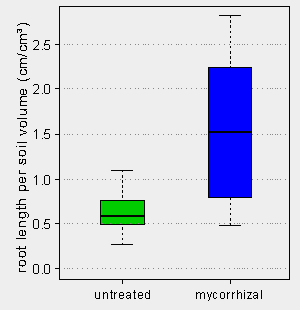
Fig. 3 - Rooting of untreated and mycorrhizal grey alder plants (Alnus incana). After a six month growing phase mycorrhizal plants have a ca. three times longer root system.
It has only recently become known that the fungi partners play, not only an indirect role in improved plant growth, but also play a direct role as builders of stable soil aggregates for soil development and stability. With their widespread hyphae network they enmesh the smallest soil particle and make micro and macro aggregates, which they then cement together with a "cement like substance" – like a bricklayer (Fig. 2). As well as the mechanical stability these building blocks also provide a reserve for water and nutrients. Because only when stable soil aggregates and pores are available are water and nutrients held back in the soil (Fig 4).
Mycorrhiza fungi also influence the diversity and development of plant communities, therefore contributing to the protective effect of vegetation. An intact "mycorrhiza foundation" is therefore a requirement for a long term, successful, stabilisation of erosion and slip slopes (Fig. 1b). Because the natural supply of mycorrhiza fungi is greatly reduced by storms, suitable symbiosis fungi have to be introduced. The same rules which apply when choosing plants must also apply when choosing fungi. Care must be taken to choose species which are suitable for the location.
For the engineers there is a further problem: they have to be able to calculate precisely the effect of the plants. Only then are natural methods suitable for employment in every day use. We are therefore at present developing a new model for the calculation of slope stability. The "gardener-bricklayer-function" forms the basis. So from a mathematical point of view roots and fungi will soon be on a par with wood, concrete and steel.
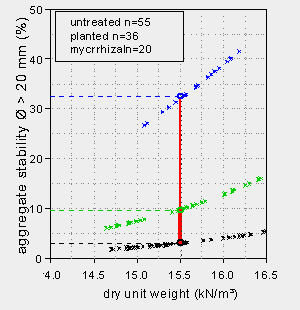
Fig. 4 - Aggregate stability in dependence with dry unit weight (soil density) of untreated, planted and mycorrhizal soil material. A six month growth period resulted in a middle area of 15.5 kN/m3 a three fold increase in stability of untreated to treated to mycorrhizal.
Translation: Dawn Meister, Stallikon

